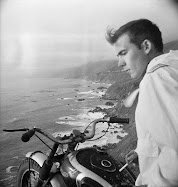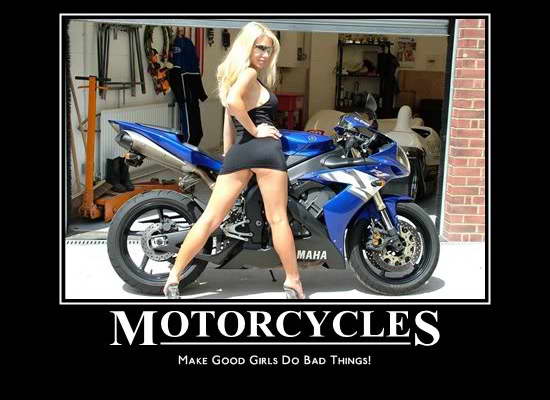Hearing a new and peculiar sound always involves some measure of disbelief. I remember the first time I ever brought a woman to orgasm. She’d been a friend long before she’d been a lover and I was astounded at the sounds she was apparently capable of making. (I initially thought I’d broken something.) It is always at the end of a long day, when I am exhausted to the point of hallucination, that some strange noise materializes from my bike — leading me to wonder if I just imagined it, or if my riding technique has brought the bike to orgasm. And even then it is normal to go through a period of denial, either dismissing the sound as a freak occurrence, or reassuring myself it is something less than $300.
It is never less than $300.
BMW introduced the legendary K75 (750cc) in 1986. They built the last K75 nine years later, in 1995. I had a bike from the first manufacturing run, and now I am riding one from the last year these machines were made too. Both of these motorcycles had several things in common: a distinctive whine, a pronounced clunk when shifting gears, and a wind-up that eventually becomes very reassuring. For me, those sounds are the equivalent of a bra snapping open or of a woman’s lips on my ear. (Though my 1986 model, “Blue balls,” is gone forever, the number of running K75s from that year is fairly high.)
 "Blue Balls"— My 1986 BMW K75 (With rare Sprint Fairing) sidebags not mounted.
"Blue Balls"— My 1986 BMW K75 (With rare Sprint Fairing) sidebags not mounted. "Fire Balls" — My 1995 BMW K75 (with Parabellum "Scout" Fairing), sidebags mounted.
"Fire Balls" — My 1995 BMW K75 (with Parabellum "Scout" Fairing), sidebags mounted. I had only had my current machine for two months (back in 2007), when I was out for a ride with Dick Bregstein, on one of the hottest days of the year. It was in July and the heat danced on Route 30 (Lancaster, Pa) until it hit 95º (f). We were stuck in stop and go traffic and the fuel pump on my K75 started to scream. I could clearly hear the noise over the traffic. A young woman driving parallel to me in a convertible looked over and said, “That motorcycle must be a piece of real shit to sound like that.”
Handling the crisis well, I shouted to Bregstein, “What does that shit sound like?” We lane-split through the traffic until I could get to a shaded spot on the shoulder. Dick is half-deaf under the best of circumstances and he thought I said, “I have to take a shit on the bike.” His response was, “Do you need me to hold it for you, or can your feet reach the ground from the gas tank?”
Neither Dick nor I know the first damn thing about motorcycle engines, so listening, looking, and speculating produced no workable solutions. We were hunched over my bike when an Amish elder in a buggy pulled up and said, “I’d shoot this fucking horse right now if it made a noise like that.”
Located in the gas tank, the pump is cooled by the fuel. Yet on that day, the tank was heated by the engine underneath, and the sun above, until it had the feel of a hot radiator to my bare hand. My thought was that the heat had something to do with it. I put 2.5 gallons of cool gas in the tank and the noise stopped. Months later, I ran into *Mac Pac rider Jimmy Robinson at our club’s Christmas dinner. Robinson fired up his vintage K100, and it made that same sound.
“I’m nearly out of gas,” said Jimmy. “That’s what that noise usually means, as the pump is struggling to suck gas off the bottom of the tank.” Robinson later admitted he’d been riding the bike with the gas warning light on for two days. Heat could not have been the problem in his case, as the outside temperature was barely 32º (f). I assumed it was a fluke and forgot about it.
My fuel pump went into the shrieking mode twice the following year. It was a hot day and the gas warning light had started to glow on both occasions. In each case, I topped off the tank and the noise went away. I’d mentioned this in casual conversation with other riders in the Mac Pac, and at least one other person claimed to have a pump that made similar sounds.
BMW riders seldom discuss their “dirty laundry” or mechanical challenges with outsiders. A common complaint about the K75 is that the gas warning light comes on too soon. In my case, it used to come on at 140 miles, leaving more than another 100-plus miles in reserve. I never minded stopping for gas at 140 miles, as my knees and back normally needed to stretch out by then. But I didn’t like being forced to stop to prevent others from hearing that fucked-up screeching sound, which either indicated a design flaw or a poorly maintained bike.
The pump did not make the sound at all in the year following service by legendary BMW wrench Tom Cutter. But I think that may have been purely coincidental. This year, the engine oil and the fuel filter were changed in my garage at home here without challenge. The fuel pump started to scream on every ride — regardless of the gas level, and the fact there was a brand new fuel filter on the gas line.
The logic of consensus said the noise was coming from the pump as a result of significant back-pressure. At no time did the engine falter nor stall. I hit 111mph on the clock during this period (with the pump running silently) only to have it start screaming louder than ever two hours later in 90º (f) heat, at only 65mph.
Perpetual Boy Scout Mike Cantwell was riding with me that day. “Goodness gracious,” he exclaimed. “What the fuck is that noise?" Cantwell heard the sound over his running engine, over my running engine, and through the flip-face, modular helmet that covered his head.
I cannot stand to have anything on my bike that is a hair off factory specs. Plus there was a real performance concern. An increased load on the pump could cause a fuse to blow or simply burn out the unit. I do not need to explain to my fellow riders what the sudden loss of fuel pressure would mean if it occurred during a fast low curve, or pulling out into traffic. So I asked more than 300 riding buddies at how many miles did their K75 fuel pumps fail and what did they pay for the part?
Not one of them had had cause to replace a fuel pump.
I ordered the part from the dealer ($333) and a buddy of mine offered to put it in. The pump came in two variations. The first of these included the pump unit complete with the vibration suppressor, the collar, and other stuff, including a nylon screen/gas strainer on the bottom (not the fuel filter). The second was just the pump canister itself ($222), enabling the mechanic to scrounge the ancillary parts off the original, thereby saving $100.
I ordered the complete pump.
My reasoning was that all of this stuff had been sitting in gasoline laced with ethanol for 15 years. I heard stories of the nylon screening dissolving and being sucked into the pump. I also heard stories of the vibration suppressor dissolving in the gas. In the final analysis, it just wasn’t practical to have the mechanic come over to the house and pull the pump prior to the 68-mile ride to dealership — and have him come back on another day to install it —just to save $100.
 Das Fuel Pump ist das part on der right. Part #1 cost me $333.00 at the local BMW dealer. I could have saved $100 by just purchasing part #2 and salvaging the rest of the stuff from the original pump. Who wants to worry about 15-year-old part transplants? The vibration supressor, part #5, is $79 by itself. It is hard rubber and I did not feel like twisting it around, until it likely broke in my hands. Part #3 is the nylon gas screen. The fuel filter mechanism is on the left. It is $29, and they have been known to last years, or until the first shitty batch of gas. Neither is in scale to the illustration of the fuel tank, bottom right.
Das Fuel Pump ist das part on der right. Part #1 cost me $333.00 at the local BMW dealer. I could have saved $100 by just purchasing part #2 and salvaging the rest of the stuff from the original pump. Who wants to worry about 15-year-old part transplants? The vibration supressor, part #5, is $79 by itself. It is hard rubber and I did not feel like twisting it around, until it likely broke in my hands. Part #3 is the nylon gas screen. The fuel filter mechanism is on the left. It is $29, and they have been known to last years, or until the first shitty batch of gas. Neither is in scale to the illustration of the fuel tank, bottom right.A retired nuclear/electric engineer, Brian Curry is regarded as a K75 Guru in BMW circles. He has taken K75s apart and rebuilt them thousands of times as a hobby. He had the old pump out in 15 minutes. I was expecting it to look like a battle-scared, gas soaked, worn-out piece of equipment. It was almost in pristine shape. The nylon screen/gas strainer on the bottom was intact and strong. The rubber vibration suppressor was as solid as it’s new replacement. There was no sign of the scum from rotting ethanol as I was led to expect. Worse, my gas tank was as spotless and shiny inside as a brand new, empty beer can. (I had half expected to find a piece of paper wrapped around the gas strainer, or to discover the strainer had dissolved and been sucked up into the pump.)
Certified Beemer wrench Tom Cutter asked me if I routinely used gas stabilizer in the tank during long periods of inactivity in the winter. I began to stammer, to which he replied, “I thought so.” Cutter explained that for fuel pumps left sitting in untreated gas for long periods of time are more susceptible to getting lined with old gas/varnish. He further explained that while the gas strainer on the bottom probably looked good, it could have been nearly clogged with varnish, while still looking serviceable. The fact that my pump had begun the death screech could have been an indication that damage had already been done.
Curry rolled his eyes as he handed me the corpse of the fuel pump. The unspoken bad news in his eyes read “Maybe the noise the pump is making is a symptom, and not a cause.” (There is a reason why Curry is not invited to weddings nor christenings.)
Others, like that happy bastard Clyde Jacobs, (who waited until I had already made the 136-mile round-trip to the dealer), also suggested that a faulty fuel regulator could be damaging the pump. This is a $135 part that lurks at the end of the fuel rail, and which probably takes 18-hours to get at. Watching Curry install the fuel pump was like observing Ray Charles play the piano. Curry had to attach the hoses and internal connections by feel, as the opening in the tank is far too small to see what you’re doing, or to even use both hands. So he did it blind.
The whole process took him less than an hour. He pressed the starter button and the K75 roared into life. The pump was again silent, but it always started out that way. I’d have to take a long ride on a hot day to put things to the ultimate test.
It took my friend a little longer to install a “Back-Off” illuminated license plate bracket on “Fireballs.” The K75’s rear running light is a dim bulb that was once used to illuminate Vatican interrogation dungeons. This same bulb casts a murky light over the numbers on the license plate. A second bulb of about 20 watts serves as the brake light. I was on a run one rainy night when the running light crapped out. Mac Pac rider Rob Haut was on my tail and claimed a bad situation was instantly worse, as far as rearward visibility went. Haut warned me about the blown tail light in the same tones that public health officials talk about clap. His tone suggested that my slipshod approach to life had something to do with the bulb failure. I hit my flashers for the brief 10-mile ride home. (The Mac Pac is southeastern Pennsylvania's charted BMW riding and eating club, and is well-known throughout the world for its accomplishments with regard to putting exotic things in its respective mouths.)
 Dual LED License Plate Frame -- From Signal Dynamics. This is offered in chrome or black, with one model coming complete with amber turn signal strips too. This unit is $79 and comes with the wiring harness. Extra are the black mounting bolts for $12. It struck me as a neat way to improve rear visibility through a cool piece of farkle. Signal Dynamics offers a full array of motorcycle accessories and lighting options. They are a delight to deal with.
Dual LED License Plate Frame -- From Signal Dynamics. This is offered in chrome or black, with one model coming complete with amber turn signal strips too. This unit is $79 and comes with the wiring harness. Extra are the black mounting bolts for $12. It struck me as a neat way to improve rear visibility through a cool piece of farkle. Signal Dynamics offers a full array of motorcycle accessories and lighting options. They are a delight to deal with. I have since made two significant alterations to the K75’s rear lighting. The first was the installation of two groups of 16 red LEDs on each side of the stop light. The rear lens on the K75 has two empty compartments that seem tailor-made for this application. The LED pods (which are rectangular) fit nicely in each, and have a factory-finish look to them. So I have the benefit of bold lighting on the back, without wires going all over the place, nor electrical tape holding up fixtures that look like LEGO blocks. Hitting the brakes causes both pods to flash aggressively — and cleanly.
There is an additional chip that lets them flash for 20 seconds, before going to steady on. I didn’t bother with the chip and these lights flash constantly the entire time the brake is on. This is illegal, as only emergency vehicles are allowed flashing red lights to this extent. I’ll take my chances with the ticket in favor of a light show to alert drivers coming up behind me. This puts the power of 32 red LEDs into my stop signal.
The “Back-Off” license plate bracket is from Signal Dynamics and costs $79. Mine is powder-coated black and has a line of 18 red LEDs top and bottom. All 36 LEDS glow at 50% power when the bike is running. They go to 100% when the brakes are applied. So as I come to a stop, 32 LEDs are flashing, and 36 others are on constantly, in addition to the OEM 20-watt bulb. When riding around, 36 LEDS are at half power as running gear. The fact that these are LEDS mean an almost negligible power drain.
Do I think that any of this additional lighting will prevent an asshole from rear-ending me? Not a shot. But it can’t hurt. I was out and about the other day, when dusk came at the usual time. There was a guy ahead of me on a cruiser and I watched as his single, chrome-framed tail light got lost in the sea of red ahead of me.
“Wow,” I thought. “And mine was dimmer than that.”
Addendum...
I was on the road for a four-day motorcycle ride through rural Pennsylvania last week. The riding temperatures were perfect, a high of about 73º, and the distance was a modest 200-miles. The fuel pump performed to spec and didn’t make a sound on the entire run. At some point, on an undisclosed road, in an unnamed state, I “pulled the ton” for about 90 seconds, but routinely hit the mid-eighties on the clock. Neither the machine nor the pump faltered once. Some guys ride because they like their bikes to make noise. I prefer the sound of silence... The mantra of precision German stealth.
©Copyright Jack Riepe 2010
AKA The “Lindbegh Baby” (Mac Pac)
AKA Vindak8r (Motorcycle Views)
AKA The Chamberlain — PS (With A Shrug)























